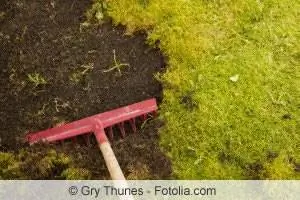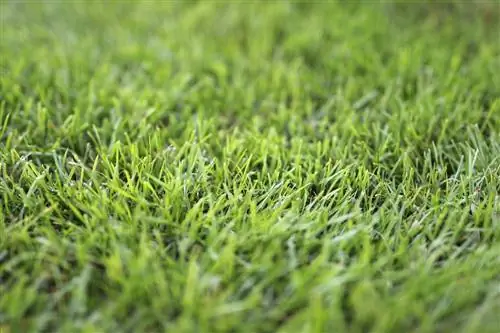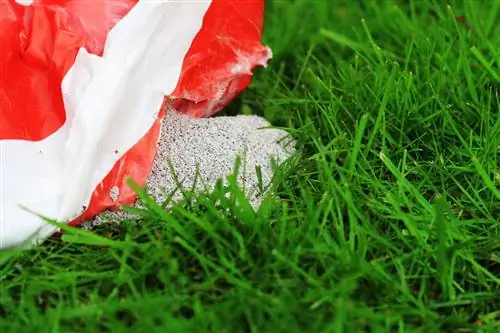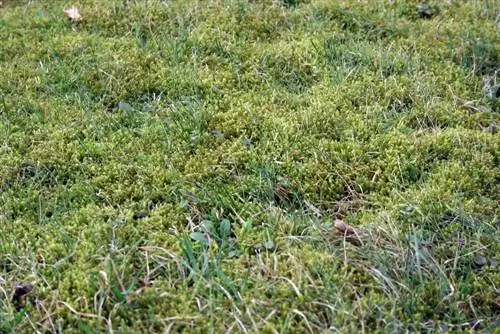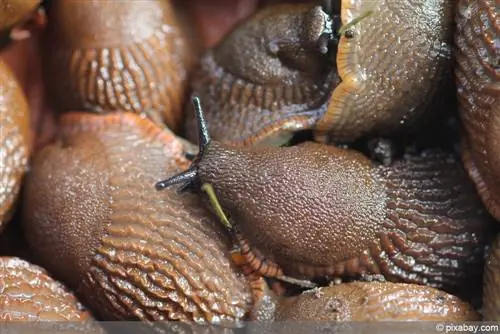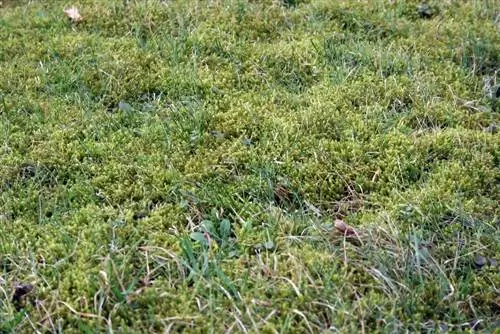- Author admin [email protected].
- Public 2023-12-17 03:39.
- Last modified 2025-01-24 12:45.
Anyone who has a lawn will be no stranger to this problem: moss in the lawn. This lawn moss makes life difficult for millions of hobby gardeners. The reasons for this occurrence are the same for all of them: errors in laying the lawn or caring for the lawn. Sometimes both. Lawns need soil that is well drained, not too firm, but also has the ability to store water. If the conditions are unfavorable - especially heavy, wet soils - there are optimal conditions for the growth of moss.
Profile
- scientific name: iron(II) sulfate
- other names: ferrosulfate, green s alt, iron vitriol, sulfuric acid of iron oxide, green vitriol
- occurs in nature as a weathering product of fool's gold
- mostly manufactured technically
- often available in combination with fertilizer
Causes of moss in the lawn
Mosses are very old and extremely adaptable plants. Like ferns, they reproduce via spores. Once they are there, they spread rapidly and quickly displace the actual vegetation. Especially when it comes to low-growing plants such as lawns. Only the lawn is cut, while the moss, which grows much flatter, continues to grow undamaged. This is usually a moss with the strange name: Sparriger Wrinklebrother (Rhytidiadelphus squarrosus). If you have moss in your lawn, there are reasons for it. If you don't get rid of these, success - no matter what type of moss killer you use - won't last long. The quality of the soil is often to blame for excessive moss growth. Most common reasons:
- heavy, compacted soils that tend to become waterlogged
- Nutrient Deficiency
- inadequate soil preparation before sowing
- unsuitable seed mixtures
- incorrect mowing (irregular or too short cut)
- too low pH value in the soil (optimal: 5-7)
- inadequate or incorrect care
Problem areas in the garden

Grass grows best in sunny places on humus-rich, well-drained soil. Even if some lawn mixtures are touted as so-called shade lawns, a gardener still has to put in a disproportionate amount of effort if he sows lawn in places that see almost no sun. Normally a lot of moss will grow in dark places.
Iron sulfate fertilizer
Preparations such as iron sulfate are available commercially, which not only destroy the moss, but also give the lawn a lush green appearance and good growth. Iron sulfate can be used as a s alt alone or, better yet, in combination with a lawn fertilizer to strengthen the lawn at the same time. The moss cannot tolerate iron sulfate, dies and dries up. An iron deficiency in the lawn can be recognized by the yellowing stalks and the sudden spread of moss.
Attention:
The iron sulfate can cause brown spots on plates, stones and many other materials!
Safety instructions
The iron s alt is freely available. It cannot be found in the locked plant protection shelf, but is usually in the lawn section of the garden center. Although it is not toxic in concentrated form, it can irritate skin and eyes:
- Harmful if swallowed
- causes skin irritation
- causes serious eye irritation
Therefore, safe safety glasses and chemical-resistant gloves should be worn when working with iron sulfate fertilizer.
Very strong moss infestation
If there is an excessive amount of moss in the lawn (over 20%), the majority of the moss should first be removed mechanically before using the moss killer.
Application
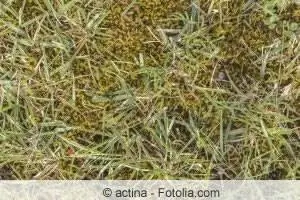
Ideally, the lawn is treated with iron fertilizer in spring, then the lawn has the opportunity to grow over the summer. However, the ground must under no circumstances be frozen. To ensure that the iron sulfate fertilizer reaches the soil well, it is advisable to mow the lawn a few days before treatment. It is best to dissolve the s alt in water before use.
- Time: March/April (in wet weather)
- Apply evenly with a watering can (shower attachment)
- if solid s alt is sprinkled: then water lightly
- Do not enter the lawn for a few days (also keep pets away)
The effect becomes apparent after just 5-7 days: The moss dies, turns yellow and then brown, in some cases even black. All dead plants must now be removed from the lawn by hand or using a rake. If the lawn is very mossy, the treatment can be repeated in August/September.
Dosage
A maximum of 25 g of iron sulfate fertilizer per square meter is applied to the lawn. This amount must not be exceeded under any circumstances.
- Dissolve 250 g iron sulfate in 10 l water
- It's best to start it straight away in a 10 liter watering can
- lukewarm water improves solubility
- Distribute the 10 liter solution evenly over 10 square meters of lawn
Further measures
As a rule, applying iron sulfate fertilizer is not enough. A few further measures will help to get rid of the moss permanently. The aim here is to create ideal growing conditions for the lawn. If the lawn grows thick, the moss has little space and sunlight to spread. Ideally, after a while no further treatment will be necessary.
- scarify (first cut the grass a little shorter than usual)
- sow new lawn in the gaps (only use high-quality seeds)
- Check soil conditions and possibly improve them
- Take care of your lawn properly
Suitable soil conditions
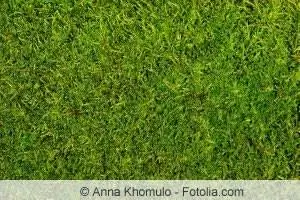
In some cases, you are making a really good investment by having a soil analysis done. After sending in soil samples, many institutes not only provide information about the nutrient content in the soil, but also provide recommendations for fertilization. You will often also receive a classification of your soil (heavy, humic, sandy) and the pH value. This makes it easier to assess what the lawn is missing and you don't have to buy unnecessarily expensive fertilizer, which in the end only makes things worse.
Tip:
You can already get a set for soil analysis from specialist retailers. All you have to do is take the soil samples and send them in. The price for the analysis is already included when you purchase the set. Prices, depending on the scope of the analysis, start at around 20 euros.
Basic rules against moss
First of all, of course, the cause of the moss on the lawn must be found out. If the problem is in the ground, the following measures can be helpful:
- water shady places just as often as sunny ones
- Frequently loosen the soil in shady places (effective against waterlogging)
- mix loamy soil with sand when scarifying
- Check the pH value of the soil (should be between 5 and 7), raise or lower if necessary
- scarify regularly (loosens the soil and creates positive conditions for the lawn)
- Mow the lawn less heavily in shady places (10-12 cm remaining length)
- mow regularly: once a week, no shorter than 5-7 cm remaining length
- fertilize twice a year with slow-release fertilizer for lawns
Conclusion
Iron sulfate fertilizer is a helpful remedy against moss in the lawn. Applied to the lawn, it works quickly and effectively against moss and strengthens the lawn. However, if you want to do something about the moss in the long term, you should also fertilize the lawn regularly, aerate it, mow it carefully and regularly and water it. This is the only way the measures will be successful in the long term.

